Text
Feedback
Linda suggested that whether the combing works is an important part, it can be not working at all or even mess up the hair, and if so, it is telling a message. Peter asked that what the arm will look like and I supposed he thought the appearance of arm tell a lot as well. if it is a robotic arm, then it has cold, mechanical, industrial feeling. if it is a very human arm, then it might look very caring. I think all of the suggestions reminds me what I need to pay attention. actually if the arm is actually an arm and the comb is a hand, that will be very interesting as well.
After I tested it yesterday (combing machine version 1), I found that the combing behavior saying completely different things --- it depicted a image that a robot is very caring, treating human hair very gently. so Linda’s advice makes a lot of sense because the behavior of the robotic arm (the speed of combing is important first of all) is telling a lot of things.
so my next step will make combing machine version 1 to mess up the hair, and being ruder to see what will happen.
0 notes
Text
Week 12
https://drive.google.com/file/d/19JLeW9RJTvkPzXxJGee3Q5RLUYLO1AEB/view?usp=sharing
0 notes
Text
Week 15
https://drive.google.com/file/d/1mXIYWZ0YY3WHpH3NhSQIWfl3YU_T5hYY/view?usp=sharing
-Artist Talk Abstract pdf
https://drive.google.com/file/d/1RiLvq9puFwMjbi_jbigT7RCR4JcmhXqQ/view?usp=sharing
- materials and note - artist talk pdf
0 notes
Text
Week 14
Chelsea visit
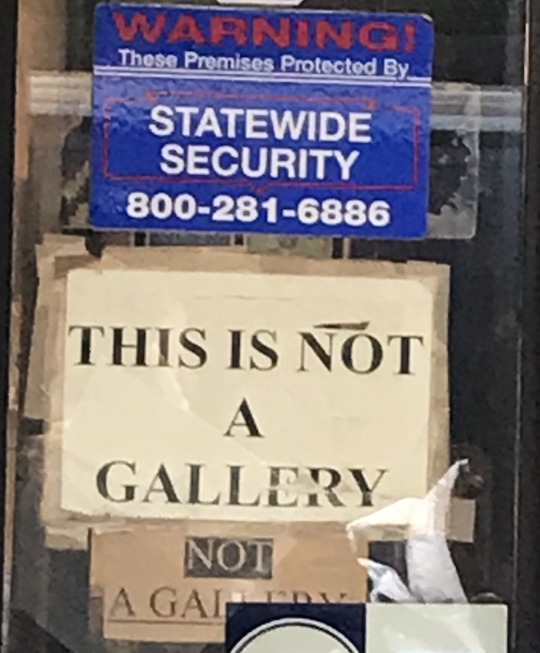
Robert Whitman – Pace Gallery
His works have a sense of cinematic kind of feeling. Well Window and the woman having a shower are referencing the scene in the movies, but even the bucket filled with blood water has a sense of dramatic tense.
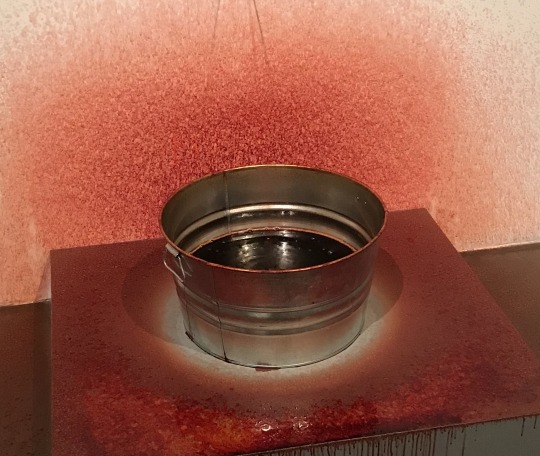
The photography with a sound is kind of interesting. The photograph is like a still version of film language, and with sound, it is totally cinematic. My favorite work in this show is the dressing table. We all didn’t notice they are same person in the first place. But the title is telling us something – “Robert Whitman, Dressing Table, c.1964 and 2018,…” even though it didn’t have a description, the two time is saying something. I like the way he hide the hint inside the title and the time.
Louise Bourgeois
She called the spiral “an attempt at controlling the chaos.” When I see a spiral in the water I felt it more like a precisely calculated physicality in nature. I kind of think everything in the nature is precisely calculated and hard to figure out. So the chaos part I interpret it as “the part that human don’t understand and haven’t figure out the calculation process”. So the drawing is pretty precise: an attempt at controlling the chaos.
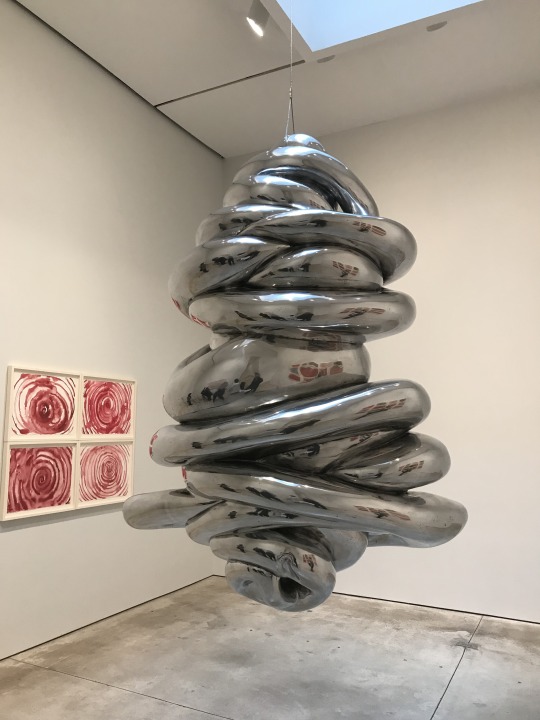
The mirroring sculpture in the middle of the room reminds me there is an article about “why is reflective sculpture always catching so much attention”, it says something like “when people are taking picture of it, do they actually like the sculpture or the reflection of themselves?”
Susan Philipsz: A single voice
After reading the paper handout, I realized there are so many reference in the piece on the first floor, there is narrative behind it. But I think it itself stands as a strong piece without any description. The feeling of isolation, loss and distance can be felt once you experience that dark room. So I think that is a very good choice not putting the description at the beginning of the film (like a lot of other video art does) to give the audience a hint or something, because the audience don’t need that to feel it, especially for the audience does not know much about music. It is a such a good choice to leave the description on the handout – after the audience finish the experience.
Lisa Yuskavage
The small scale paintings look super delicate when displayed as a line on the wall, the audience were getting closer and stayed focus on the details. I noticed these paintings seems like digital drawing, maybe it is because of its color. The color is bright and digital-feeling, has a sense of Japanese style digital drawing. But the theme of them look so feminine, it is very interesting to see these features to be combined.
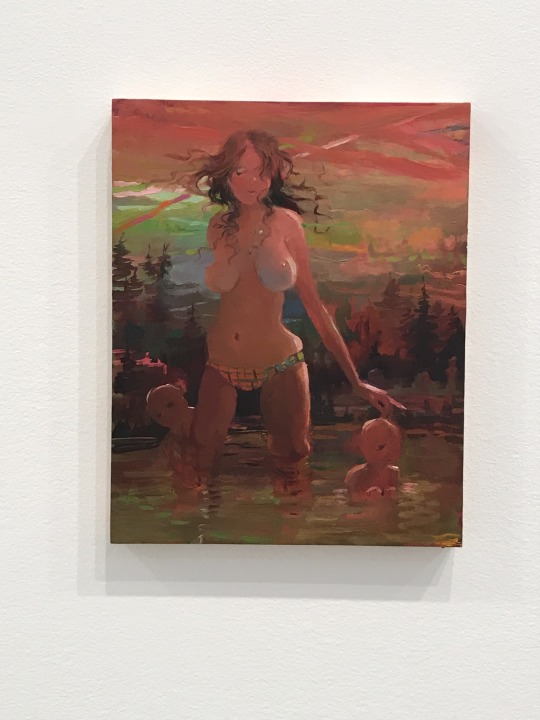
here is a online digital drawing randomly found

0 notes
Text
Week 13
Moma Bruce Nauman
Going Around the Corner
The work Going Around the Corner feels like the focal point of the exhibition. Four sides of the cube are each equipped with a monitor and a surveillance camera. However, the monitor does not show the image from that surveillance camera, but shows the image from the surveillance camera on the other side. The disjunctive experience corresponds to several works that he created, for example the famous corridor. They both confuse the audience’s sensation and perspective. The feeling of dislocation gives a strong meaning and description to the title of the exhibition “disappearing acts”. The Moma’s description on the wall, “with minimal means, these structures trigger physical sensation, calling attention to ‘how you locate yourself in space and doing something to confuse that’” describes the work so well.
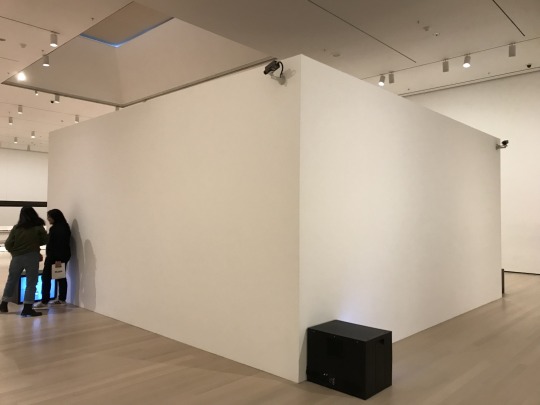
Bruce Nauman’s corridor
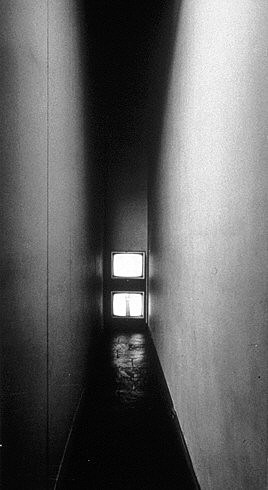
Audio-Video Underground Chamber
There is a small television in the corner, behind the sculpture but I found it attractive. It is a live-stream video streaming the scene in a chamber. And the image just keep still and no one will notice if he just took a screenshot and play the image, or if it is glitching or something. Basically the execution is similar to Nam June Paik’s TV Buddha (and it is very suitable to add it into my exhibition proposal project, it confuses the audience a lot). The different part is this one is literally in the coffin, the place where nothing will move, or accidently be moved, it is a place that is still like death. The description on the wall said, “located off-site, the chamber is constantly monitored but always out of reach, and no event or change relieves the monotony of the silent broadcast.” And the camera inside the coffin is a working security camera, and we are watching through it at emptiness, a “blank abstraction”. I feel that this is one step deeper than TV Buddha.
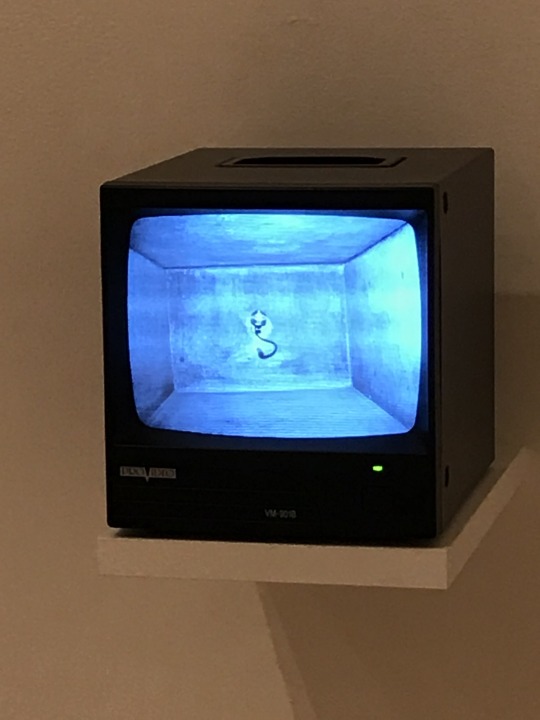
Surveillance camera vs “disappearing acts”
The use of surveillance cameras in Nauman’s works describe what the title means by “disappearing acts”. Like Going Around the Corner, you stand in front of the monitor but you “have disappeared”. But the security cameras technique itself works quiet like “disappearing acts” – you don’t know where your image is displaying at, maybe it is on a public website, maybe in front of a security man, you never know if anyone is watching you. A man who “might not exist” is watching you – isn’t that a disappearing act?

Days
“unlike the day, the year, or the seasons, the week has no basis in nature – yet its familiar sequence is fundamental to how we organize our lives.” the corridor of sound messes up the order in our lives. Because the sound are from different kinds of group in different ages, it made me think that the intension is to say the orders of days in their life is different. I spent a long period of time staying there trying to find the laws of the random orders, but I didn’t find any – they might be just random. And the elderly sounds slower, the child sounds much faster, which is kind of referring to the feeling of time in different period. It reminds me of the movie “The Night Is Short, Walk on Girl”, in that movie, the watches on elderly’s wrists go really fast, and the watches on the young’s go really slow. The feeling of time passing is different for different ages, the corridor feels the same way to me.
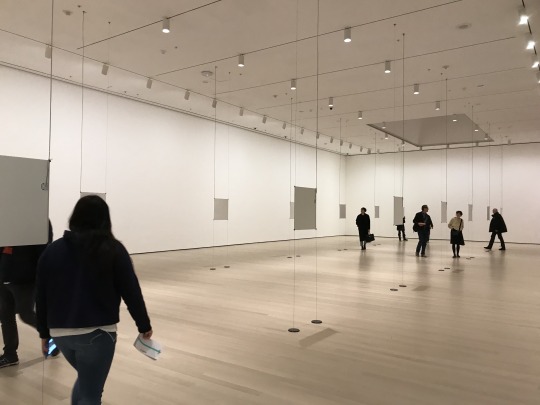
One person per hour note.
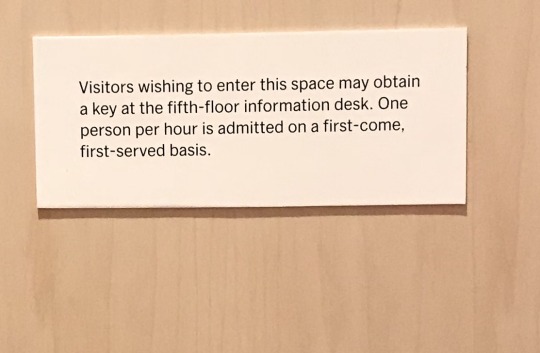
There is a note on a very narrow corridor and there seems to be nothing in it.
Stelarc Reading
I agree with some of the statements in the reading, even though they sound horrible. But I doubt the part that he is talking about death. “the body much become immortal to adapt”, I don’t think a lot of what we are doing means anything if we are immortal. Technology exists kind of because of the limitation of life, so people want to spend shorter time doing what they don’t want to do. So maybe immortality and technology is somehow conflicted.
I like the part about anaesthetized body: “technology pacifies the body and the world, and disconnects the body from many of its functions. Distraught and disconnected, the body can only resort to interface and symbiosis.” If bodies can be modified as whatever people want them to be, the aesthetics of body would be completely changed. The aesthetics will no longer relate to the functions, such as fertility. That might be a very interesting phenomenon then.
Then I have some doubt about the following part about the limitation of the bodies. However, you develop the bodies, make it as computer, or like he said, take in oxygen directly from the skin, there will still be limitation – you need oxygen anyways, if people become robots, they need electricity anyways.
Progress on Artist talk project
The transition from illustration to new media art was a difficult decision. It was decided by a lot of factors but the main one is that I don’t want to be limited by media. I understand that there are a lot of people feel devoted to a particular media, like print making, painting. But I found that my interest in art is to say something, similar to writing, stick to one particular media sometimes limit what I want to say. I goes from one another in these years and I am still exploring. The future goal or what I am doing now is exploring and find and develop a favorite media to express what I want to express.
0 notes
Text
Week11
Guest lecture
He is such an energetic performer and he seems very smart. It is very true that he said there is always context and meaning when two things met. The artist himself is utopian and contemporary, which already has a context and means a lot. If he lived in an older age and he is utopian then that create totally another context. Same, if you display two art works next to each other, they will generate some unique context, sometimes very different than just put them one by one.
Exhibitions, institutions, communities, collaborations
E.A.T/9 evening
I think on the level of the essence, art serves as a panel through which a lot of conversation can be spread. Like mural art, the size is for reaching more people, there are some articles describing the similarity between mural art and radio. I agree very much that art serves as a kind of form of radio, spreading the information to the public. Like this collaboration work, the engineers and the artists make it big to spread the attitude that they have, like a public speech but in the form of public art. It reminds me that I had a science class in my undergrad school, the teacher is a scientist and worked at NASA for a long time. She said she wanted to teach at an art school because she wants science to reach more people, let more people notice the global warming and climate change.
WGBH
The behavior that a Public television station televising experimental videos art is very experimental. Because television is aimed for entertainment, but video art is not. I would think that some of video arts is actually a satire on the television, and some of the video arts are even against television, like Chris Burden pay to air his performance of slithering across broken glass on a local TV station to convey his attitude about television. Anyways, televising video art is a very experimental act because these two thing are kind of in contrast.
American Museum of Natural History in collab with NCSA
We had a field trip last week to meet one faculty who worked in Natural history museum. She introduced their working process, transiting scientists data to visual installation. There are some long sheets with numbers and they are responsible for visualizing that number sheet. Public spread of knowledge like museum needs both creativity artists and scientists.
Rhizome.org
I found that the artist Akira Hasegawa has done a lot of projection mapping on famous building. He did a project on Kumamoto Castle. I think it is very interesting putting historical architecture and projection mapping, its like forcing the historical architecture to confront modern technology.

video link:
https://www.youtube.com/watch?v=i43faP_bVBk
0 notes
Text
Week 10
Guest lecture
I am very interested in experimental 3D animations and installation, which was once my focus in 2017. I do like some of his aesthetic like layering and neon aesthetic. For example, Supersad(e) shows a very impressive slit-scan, glitching aesthetics and I like that very much. But I do agree with what others say in classes, the connection that he make between disney world and others sometimes seems flat, such as the one refering to 9-11. I am still wondering the relationship between the bambis and the clapsing buildings. In addition, I think sometimes the move in his work seems simple, I understand it is a style, but I still think it seems a bit simple. I don’t think repetition works if one scene is played once again from another camera to emphasize on what he is saying.
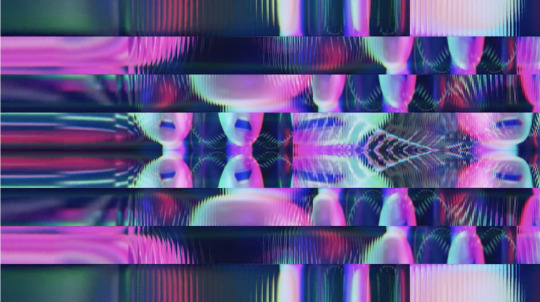
Artist Talk preliminary thoughts
Science background in High school
Judith Butler’s book Gender Trouble influenced me a lot. For a period of time my works are talking about feminism. (I was in Illustration major)
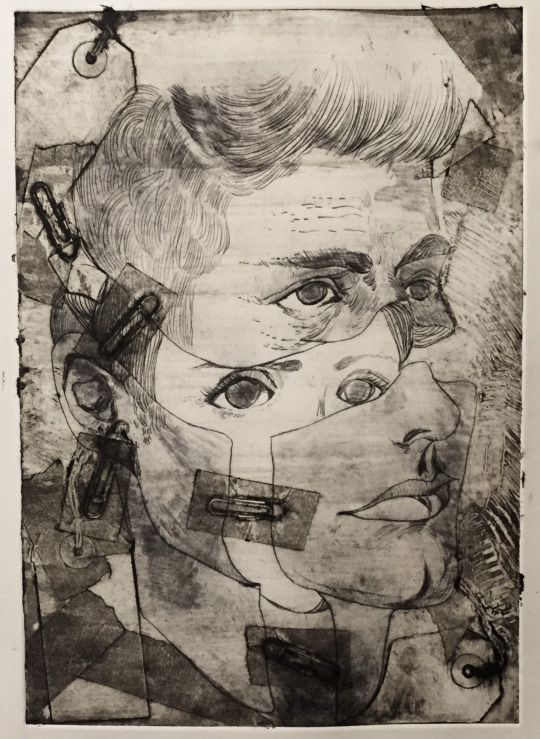
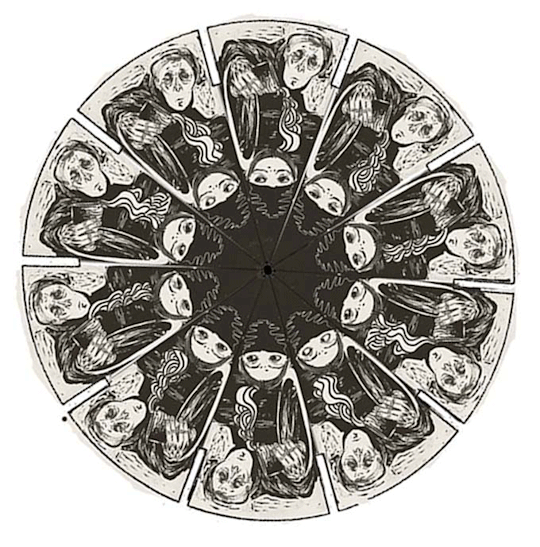
I was also into the relationship between human beings and technology already, especially phone. The aspect I took then was that I think people partly live in the virtual world created by phones, so that they feel really safe when the phone is fully charged. They feel safe when the phone is with them, like carrying a home with them, so that they can get into that home when they find it boring or awkward or uncomfortable, like when they are on the train/ in the elevator.
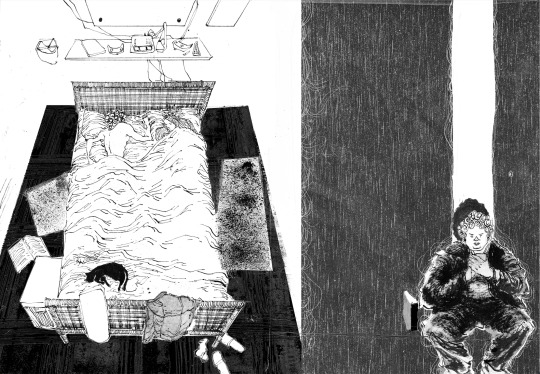
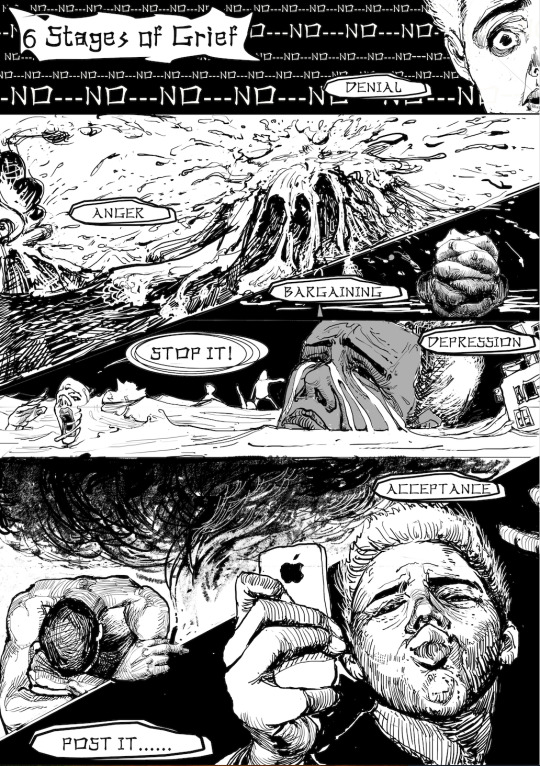
Then I want to be more free in the media I use, so I transferred to SAIC, in which there is no a fixed major. at the meantime I have not been doing feminist theme since then, because I found that what really attracted me is the “deconstruction of gender” part in Judith Butler’s book. later on I kind of moved my direction to deconstructing things.
I found scientific aspect and philosophical aspect are most of the time opposite, if you see things in biological way, some of the philosophical questions seems not meaningful any more. but I think that is also what contribute to what I make today. From a biological aspect, the narcissism of human beings as a species is not making any sense. I address that idea sometimes in my work, which titled anti-anthroporphism.
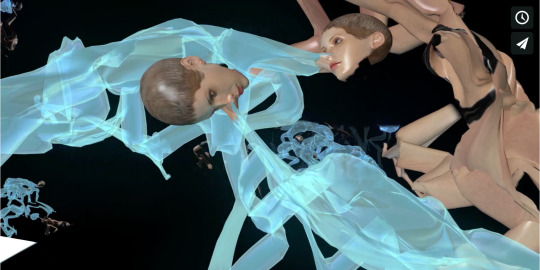
Existentialism influenced me a lot as well, I made works exploring self identity a lot. In the current time I like deconstructing the existence of individual in some certain context( if that make sense?) for example, the “self” in a virtual world, social media world, and the physical world with your own cultural context.
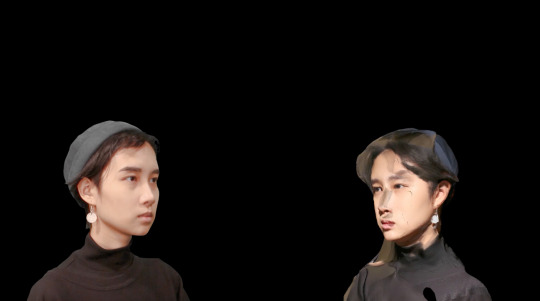
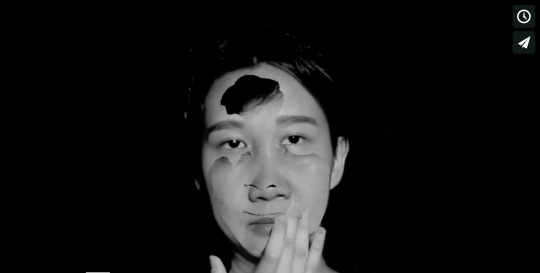
Some artists inspired me a lot in that perspective. For example, Ed Atkins and LaTurbo Avedon, who are both artists that focus on 3D, Ed Atkins made an super inspiring work Safe Conduct, which shows me what experimental 3d can do to express his perspective of conducing a security conduct.
youtube
LaTurbo on the other hand, is a virtual avatar themselves, who really speak for some discussion in the realm of existentialism. One of their works is taking snapshot of their avatars playing in computer games.
0 notes
Text
Week 9
Guest lecture
It seems that he keeps experimenting with animations throughout these many years. I really like the way he includes his finger (maybe that was not his) in the animation, making the animation less “formal”, which seems like a “behind the scene”. Involving the artist finger has the perspective of God as well. Having a finger there emphasizing the fact that these mimic moving things is a trick that I create to make you believe that this is really moving. Having a finger there also drag you back to the reality when you want to immerse in the world of animation: a world that things move in a logical and a non-logical way. In terms of finger, it reminds me of the discussion about why Cartoon character has 4 fingers in western animation. It is not only because the fact that 4-finger is a lot easier to animate than a 5-finge, it is also because that 4-finger kind of emphasizing that is an animal, is a hint that this is unreal. I think it kind of show a hierarchy of the creator and the creation?
Critical paradigms chart
It helps a lot to understand the art history flow and what the development was in art’s different discourse. One most connected to what my perspective of what art is Cognitivism, in my understanding of art, it is a thing that expresses your thinking in a more abstract way then literature and philosophy and science. Seeing an art work is like communication with the artist about your thinking in an abstract way also. And I believe the cultural history in sociology and other subject would show similarity with this chart because art seems to be one of the reflection of the thought of history and society.
Jean Baudrillard
I read his book “consumer society” a few years ago, and after reading these articles today I am still not sure if I am getting his idea right. the concept of the simulation and simulacra seems similar to the concept of “post truth”, which indicates that what is truth does not matter anymore. Like a word that was originally means something, but more and more people mistaken it as another meaning, then the word might change its meaning as all people believe that it means another meaning. A fake news got circulated on the internet, and people believed in it, and then some social changes happen, at the mean time the fact that this is a fake news does not matter, because all people move on and some changes already happened. The concept of simulation and simulacra I understand that as something similar. More and more people believe in the simulation of the reality, and then there are more simulation of simulation generated and created, the reality just does not matter. Just like a women is actually just cooking for herself, but the image of her cooking is playing on the TV, and the model of the perfect housewife will be reinforced and more people simulate this image of housewife who should be cooking at home. But I still don’t really get the metaphor of that short story of the map.
0 notes
Text
Week 8
Char Davies
The work seems to be simulating the feeling and the sensation of nature. But I don’t really see the point, what is the point simulating the nature? Seems like a lot of interactive works, especially VR works, are simulating the environment of nature, I see the beautifulness of them, but I am don’t see the point of simulating the nature, I mean it is just there outdoor.
Mary Flanagan
The work is interesting in terms of putting a story in memory in a game environment setting. Telling a narrative in a game environment attract people’s attention and engagement. But in the context of the audience is playing this game and experiencing the house fire memory at the same time, there is a conceptual aspect about it – there is nothing fun about it, and the player of this game is walking in this memory and he cant do anything about it. It is interactive but there is no choice. Also, the artist has a very detailed webpage and a very inspiring artist statement that I can learn from.
youtube
Shaw et al.
After I read the description of the work on their web (seven domains of the work: material, language, macrocosm, association, union, person, emergence.), I think it is just far too broad, I won’t feel the seven domains even if I was there and actually experiencing it, I think the artists are just adding too much content in it, and the execution is less than what they are trying to say.
Dan Sandin
he is kind of creating a virtual, stunning world and the audience can enjoy the imaginary world in VR, which is kind of what everybody does in VR. But the fascinating part about him is that I found the bio of him saying “In recent years, Sandin has been concentrating on the development of auto stereo VR displays (i.e., free viewing, no glasses)..” so it seems like he is trying to get to another layer of virtual reality- without the glasses, which may get to another layer of simulation, and what is the top level of simulation? Is it like in the movie and everyone lay in an egg and experience everything in their heads?
VR work
Nicola Plant - Sentient Flux
the work allows the audience to interactive - seems like adding another layer to VR work, including interactive aspects, something like a combination of screen interactive work and VR experience. it detects your motion and add some particles floating, like interacting with processing in a 3d space.
vimeo
Simulations and simulacra
I think among these VR works, the most artistic part about VR works is just the VR thing itself. Sometimes I can not see the point about using VR to say what they want to say, or they are just pushing the idea of virtuality – reality boundary, but that is already indicated by the technology VR itself. I mean, the whole VR experience is about the disconnection and disassociation, part of our sense (visual, sound) is in the virtual world but the rest of our sense (feeling the touch) is in the physical world. You are still worried about if you are stepping on the edge or other limitation, which is the fun part of VR, it is kind of splitting you into two world at the same time.
0 notes
Text
week 7
pdf link: https://drive.google.com/file/d/1odMf8PVdlySkyYgmGAv4XYbIuBqyKa6_/view?usp=sharing
Exhibition Proposal – Zoe Li
Frustrating Media
Abstract
Frustrating media shines a spotlight on a body of works presenting media installations including videos, photography and sculptures between 1971 and 1993. Featured works address the relationship between human and media, deconstructing the position that human, media and technology take within this relationship. The artists are intended to frustrate the viewers about their expectation toward media when presenting TVs that are not regarding people as their audience, or a video camera is not recording static livings, or a movie without its tension and engaging power. These artworks especially disrupt the entertaining expects of media, presenting a confusion about spectatorship between human being and media.
When the media functions out of expectation, some questions will be raised: what do media mean to human being? what do they mean to you when you leave the TV on while cooking? Do you consider them to be broken when they function not the way you expected? As Neil Postman argued, “cultural life is redefined as a perpetual round of entertainments”. The body of works encourage audience to think about the meaning of technology and media when the entertaining essence of them is removed.
Description
The selected art works include diverse presentations of media to comment on media-human relationship. They are performing out of ordinary to frustrate audience’s expectation on how they are supposed to be.
We expect to be entertained by TV and expect that we are the spectator. When TV for TV switches the spectator to another TV and denies the existence of human being in their relationship, it frustrates our narcissism and questions what we essentially expect TV to provide. What does a TV means to human when they leave it on while staying in motels or at home alone, although they are not actually watching it?
We expect that cinema is an immersive environment that violently engage the audience with its tension and static narrative. When 24 hour Psycho presents itself as a 24-hour projection, all the tension, drama, any element of entertainment has been removed. The cinema loses its feature of violent engagement or immersive sense. As Neil Postman argues in his book, in the age of television, “cultural life is redefined as a perpetual round of entertainments”. All the discourse and information has now become entertainment. What is left when the entertaining feature of cinema is removed? What the movie Psycho means when it is extended to 24 hours and no longer attracts audience?
We expect that video camera to record static living, because that is the reason why it is invented. It barely differs from camera when it records a still object, such as a painted wooden Buddha. The television monitor is live streaming the image of the Buddha, which is largely similar to a still image. What we expect from a television monitor is spectacularly entertaining moving images, advertisement and diverse TV shows that would not let your eyes rest. Now when a still Buddha is showed on the television monitor, the temporality and fragmentation of information on media has been removed.
We expect that we are the spectator and the media is the spectacle. When Vito Acconci pointing at the audience with his finger in the video, he at the same time questions the spectatorship. The original piece is that the artist was live streaming this video. The audience were feeling more pointed at by the artist or the monitor. The artist was pointing at himself, pointing at the camera and pointing at the audience, so which one is supposed to be spectator and which one is the spectacle?
Neil Postman argued that media-metaphor has changed social conversation:
“When a population becomes distracted by trivia, when cultural life is redefined as a perpetual round of entertainments, when serious public conversation becomes a form of baby-talk, when, in short, a people become an audience, and their public business a vaudeville act, then a nation finds itself at risk; culture-death is a clear possibility.”
Featuring art works from 1971 to 1993, Frustrating Media frustrates the audience’s expectation on media by disrupting the entertaining spectatorship associate with the media, questioning what media means to us when they function out of our expectation.
Postman, Neil. Amusing Ourselves to Death: Public Discourse in the Age of Show Business. New York: Viking, 1985., 1985.
Artist description
Nam June Paik (1932 – 2006) was considered as the pioneer of video installation and one of the founders of video art. His installation combines audio, visual, and electronic elements, showing an anthropomorphic feature on technology throughout his art. His works discuss the relationship between technology and modern man.
Vito Acconci (1940 – 2017) was a Brooklyn based artist who has significant influence in performance, video and installation art. His practice includes sculpture, architecture, video, performance and design, questioning the boundary of private and public realm, the nature of gender and so on. He is best known for his controversial body art in the 60s.
Douglas Gordon (1966) is a contemporary Scottish artist who lives and works in Berlin, Germany. He works in performances, installations, photography and video. Some of the characteristics of his work are appropriation of cultural sources and the ability of disrupting perceptions. He also experiments with the concept of time.
Takahiko Iimura (1937) is an Avant-garde filmmaker and artist who has a significant contribution to the development of experimental cinema. His works mainly focus on video installation and sculpture, deconstructing the language and power of video. Iimura has been experimenting with the medium and the spectatorship toward medium and questioning its authority.
Image
Nam June Paik – TV Buddha
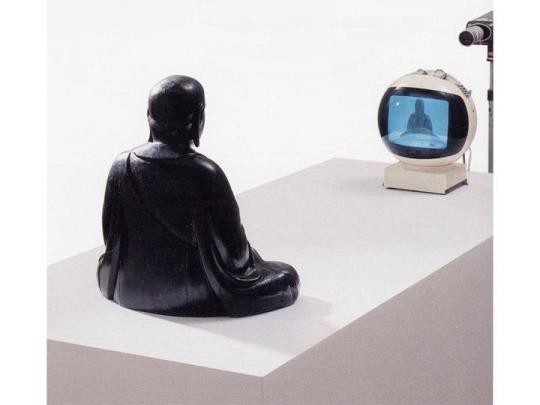
Nam June Paik – Kaldor candle
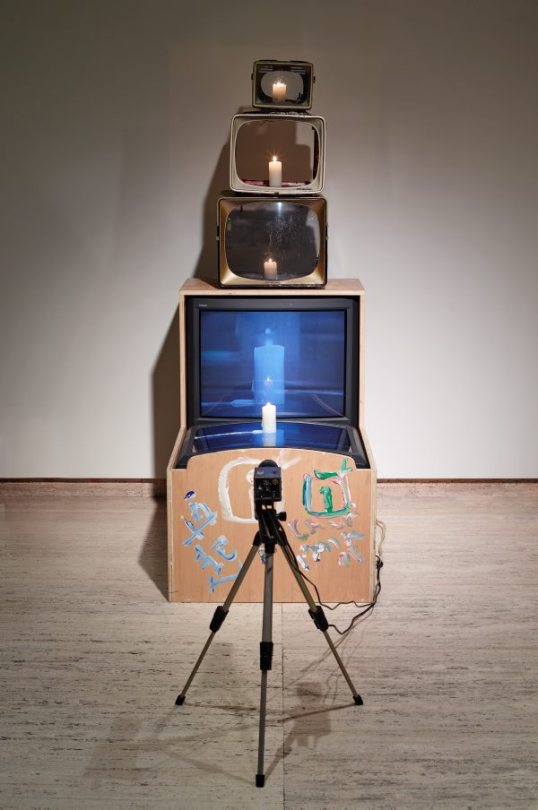
Vito Acconci - Centers
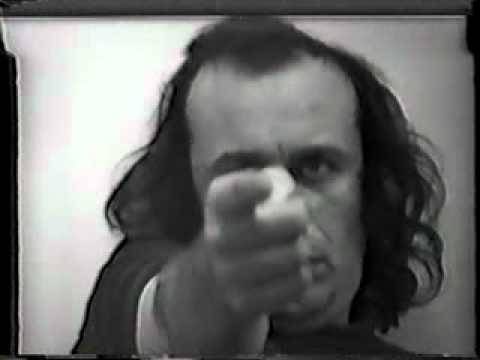
Douglas Gordon -24 Hour Psycho
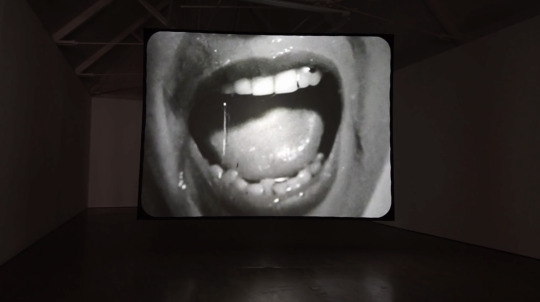
Takahiko Iimura - TV for TV
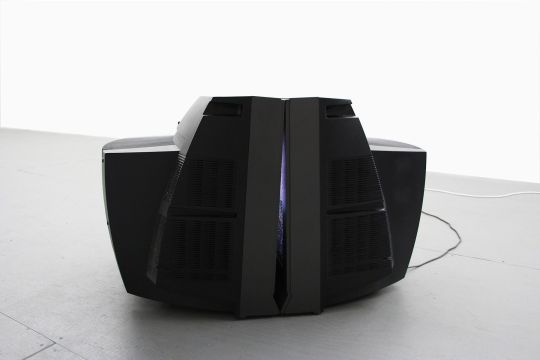
Label
Nam June Paik
TV Buddha (1976)
television monitor, video camera, painted wooden Buddha, tripod, plinth
Buddha: 75.0 x 36.0 x 36.0 TV monitor: 32.0 x 32.0 x 32.0 cm
Nam June Paik
Kaldor candle (1996)
closed-circuit camera, tripod, 3 metal television shells, 2 television monitors, candles
wooden base- 99.5 x 70.5 x 102 cm; 3 x TV stack- 84 x 41 x 40.3 cm
Vito Acconci
Centers (1971)
Single-channel digital video, transferred from video tape, black-and-white, sound
22 min., 28 sec.
Douglas Gordon
24 hour Psycho (1993)
Video
24 hour
Takahiko Iimura
TV for TV (1983)
Two identical TV monitors face to face
Dimensions variable
Exhibition Layout
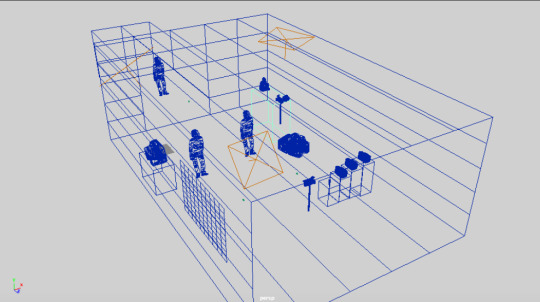
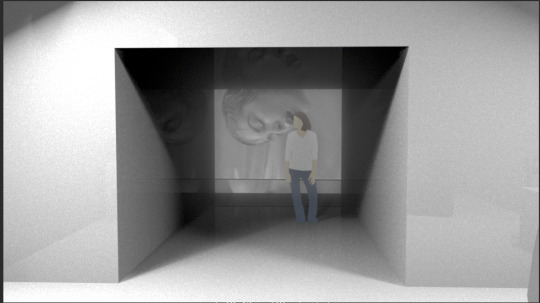
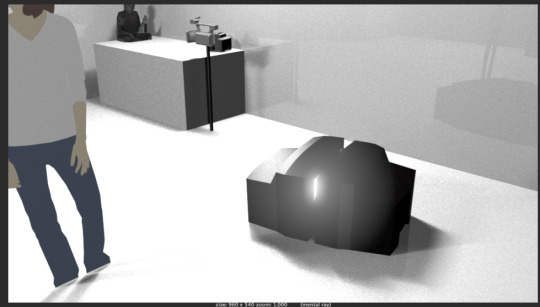
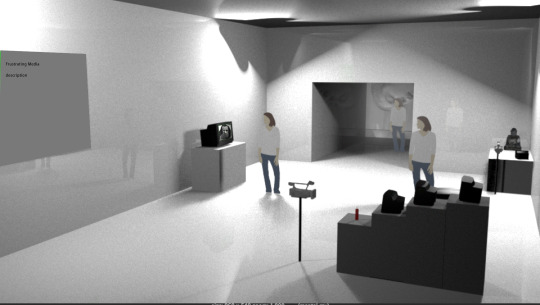
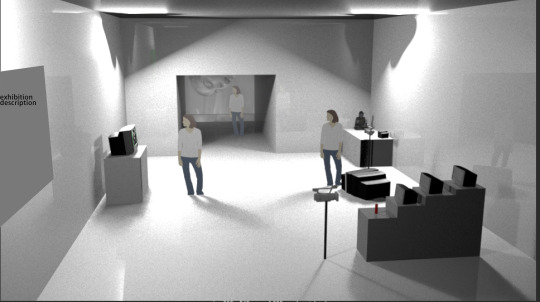
DDA Alumni show
I saw Taezoo Park in the opening and I asked him if I can touch the knobs on his work, he said of course. But no body touched the knobs before I ask, just not so sure if it is an interactive piece. It is entitled as TV being but it looks like a surveillance monitor? Most of works are not easy to understand without a description. There is one work - a family siting on the sofa and the background is the fire outside the window. I think the perspective interests me because I can image that they are watching television and we are watching them on the perspective of a television. Visually the four digital imaging works stand out most, with satisfying color and composition. What I can read from it is the artist trying to make a statement about the contemporary cultural artifacts, such as chewing guns, mcdonald’s culture etc.
0 notes
Text
Abstract
The selection of the works are displaying a different way of regarding media. The artworks are intended to frustrate the audience about their expectation toward media. In the relationship between human being and media, there are fixed roles according to the common use of media, and the intention of the invention of the technology, such as human are supposed to entertained by TV, TV’s audience are supposed to be human;
Description 500
Artists
Images
Label
0 notes
Text
Week 6
Harold Cohen
There is an interview that Cohen was asked is the computer being creative. And he answered that of course it was creative: “I think creativity is a relative term, clearly the program is creative in terms of every time they did a draw that I have never seen before, but for the program to be a complete sense of creative, it has to be able to modify its performance.” I think this is an inspiring question because the program is of coursed programed by thousands of rules and algorithm (as I image it). And it consists of so much process of computer training, which is coming from the existing data and maybe a large amount of paintings. You could say that the program is “generating” a new painting instead of “creating” a new painting, but does that mean the program is not creative? Well, if I think of artists, who is a bunch of people that absorb a lot of things from the surrounding, visit a lot of shows, do a lot of readings, and then “generate” some arts based of the content that they have in mind, which is quiet similar to this program!
Chris Burden
I wonder how many scars are there on Chris Burden’s body as his every art work basically is self-destructive. It seems that he enjoys torturing the audience. it is super torturing to watch a person being tortured. I think it would be quiet an experience to watch Burden being shot in his performance Shoot. The description online about this piece is suggesting the electricity is violence, just as the same as the connection between the TV and human. I think it is an impressive and super powerful way to comment on this violent relationship between technology and modern people, and it is very accurate and true.
Shoot -
youtube
Atsuko Tanaka
It seems that the artist is also commenting on the body – modern life relationship, because the artist use her body covered by the light bulbs. But as the artist is female and the environment where women were expected to stay in traditional roles, it has more feminist context. If the art is made by female artist in Western countries I might relate it less to a feminist statement.
Antunez Roca
I easily link to the experiment at Yale, especial the part that the audience is encouraged and asked to conduct the punishment. Under authority’s comment people are de-personalize themselves to conduct that act, which makes them easier to comfort themselves to do things that seems wrong. And it feels similar to Yoko Ono’s cut piece, giving audience the power to cut. Her own interpretation is that she is giving what she wants to give, and the audience is allowed to take whatever they want to take.
Yoko Ono - Cut Piece
youtube
Stelarc
The artist raises several questions when he turns himself into a robot that is controlled by the internet, commenting the existence of human body in the digital age. The third hand which he can control seems to me has the meaning of : the only control that he can conduct of himself – which is even not belongs to his body. The artist is playing with the context that “robot” is something can be controlled, which is kind of the definition of “robot”.
Jim Cambell
What I took from this piece at the beginning was a deconstruction of the behavior of reading. As the Bible is the same text, but the comprehension of the bible differs, so that there are several branches of the same religion. In addition, I think the title of the piece gives me another context – the artist’s voice is reading it, but the artist himself didn’t read it. I think the most wonderful part of this piece is the title, without this title I will simply connect to the deconstruction of reading.
Ken Feingold
This work visually is very impressive and I believe the audience who have been to see this art would think that too. I don’t have much feeling about the content of this work. But the work left me one question, if I create this scene in Maya, or make it as an animation, with the same dialogue and idea, it might not seem so impressive visually. So why it became powerful when these are actual objects in the physical world?
Bodies, Surrogates, Emergent Systems
The short paragraph mentioned that some artists used genetic algorithms or viral behavior to make works about this emergent system, which inspired me a bit about the algorithms that constitute human being, such as genetic algorithms, the difference between us and the machines might be that we have much more algorithms than them, for now. quote “examine the cyborgian nature of human existence and to ponder what a post-human existence might be.” (I am quoting this only because I use the word post-human a lot in my work)
Exhibition proposal update
Michael talked about that I can think about: the artists frustrates the expectation of media or the media-related people, so that the views can think about/realize what their expectation is.
0 notes
Text
Week5
Exhibition proposal critique
During the critique I figure something clearly by the reviews from our classmates.
My topics is more like the media is not doing something that we expect them to do, instead of they are not functioning. So my direction might change to the way that the media doing something anti-expectation. But I still need to think about what else I can read from and describe from this, something like media under expectation and a conceptual way of functioning?
It was suggested that the word Narcissism would be a good title and there is more context for a show. It is said in the article that the aesthetic of video is narcissism and there are indeed many artists who have made artworks about this perspective.
Nam June Paik’s work TV Buddha was recommended and I think it is a good fit into this topic. And I found another Paik’s work Kaldor candle (1996). Both of these two works employ a conceptual use of video.
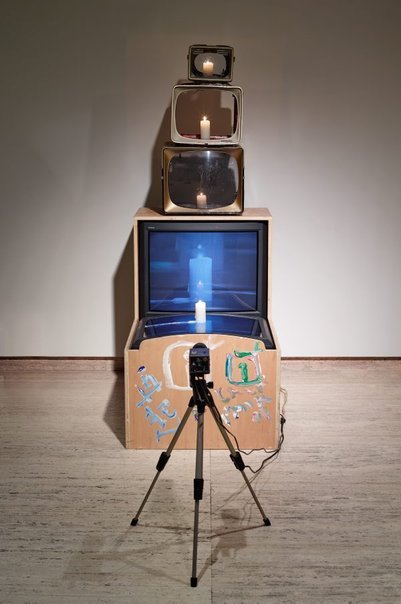
Also Michael suggested I can look at more contemporary works. Also I was inspired by Qinyuan’s subject about this different context of environment throughout the time. I can also look into the timeline about how the media were used and expected to function. There is a more contemporary artist that I really like is Adam Harvey, he did a project that he painted the model’s face in order to confuse the face recognition computer system.
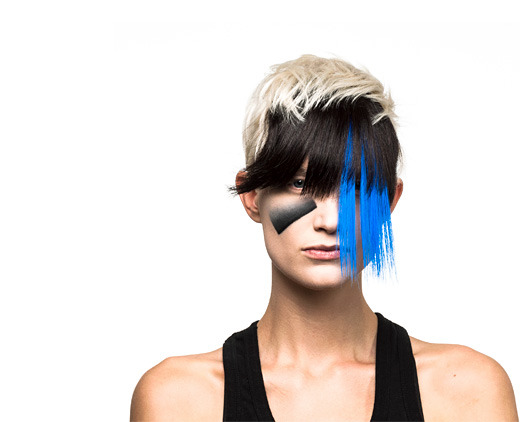
It raised the discourse of the relationship between media and human contemporarily. If we think about the timeline, when media first came out, people were surprised by them. Every family was enjoying them and TV become such a huge historical cultural artefact. The relation was more like how they expect the media to work. While in the digital age when media become overwhelming, the attitude of human toward media become uncertain and people feel uncanny and insecure as the technology developed as they can not image. The art work is showing the relation that how people expect the media somehow not to work. The most interesting about this art work I think is that human try to develop technology but at the mean time they are hoping they can do something to avoid it, the relation is so uncertain.
Necro Enema Amalgamated
The attitude they have on interactivity is fascinating. In their manifesto they said that interactivity is a lie. “interactivity is giving a user more buttons to click is like giving extra links to a dog chain.” They are referring to democracy and I think it is a very precise description, no matter is it describing politics or interactivity itself. So the interactive part about this magazine is that the format seems to be interactive, but the content is actually overwhelming and manipulating the audience feeling easily. I fell very uncomfortable seeing the work online - https://www.youtube.com/watch?v=wbR89xRfNCg
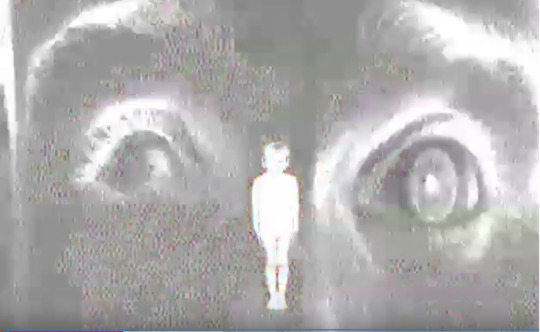
And it seems that the whole magazine is doing this visually super uncomfortable style and just telling the audience, you think you are interacting with this magazine but actually we are just forcing to close it.
Johannes Gees and CALC
What I don’t understand is what connects these individual and make them form a community. By the description I don’t really understand how it works. I guess it is like a map with artist that focused on diversity and globalization? It is always tricky to describe the data generated art work.
Hans Haacke
That reminds me of the saying that data visualization is so broad. For example, this work, real-time data transformed into the text coming from the machine. Also, if I note down something that is happening in front of me, is it a kind of data visualization? Another interpretation of this work will be that this is an art work which interact with the world. It is basically responding to what is happening all around the world at the moment. I like the work in a way that it provides another perspective of what an interactive work should be.
0 notes
Text
week4
Guest lecture
I think they both have interesting ways to tell stories. I like Ariel’s way of tell, and I even think that she doesn’t need storyboard, I feel that she is still exploring and experimenting.
After the lecture we talk about the similarities between Emily’s animation and Wong ping’s animation in One Hand Clapping. We found that they both have a lot of strong cultural/political address. Which make me think that is it all art considered political? Because the artists are eventually expressing something, even though they are not, their work will be interpreted as some political aspects because the point about the artwork is that they are open for the public and discourse.
Joohee Park and Taezoo Park
Taezoo Park’s works reminds me of Nam June Paik’s machine robots, exploring this kind of machine being and evolution. Joohee Park and Taezoo Park both work on the theme of creature? Joohee Park’s work is more focus on the immersive 2d experience. I wonder what is her direction in Digital art.
Daniel Rozin
I remember one of my professors talk about him when I was doing an interactive piece. He said this is a very simple piece but effective – it attracts attention and there are always people around it and interact with it. I am pretty sure he does not like this piece so much because he described it “direct”. It makes me really think that how to value an interactive piece, depend on how much attention it draws? Or how effective the final piece is? Indeed, the artist is doing a simple thing – mirroring the audience, and I don’t feel a lot of meaning behind it. But the outcome is indeed super satisfying. It is very enjoyable and fun to interact.
exhibition proposal thoughts
artists and works
Takahiko Iimura, TV for TV, 1983. Two identical TV monitors face to face, dimensions variable.
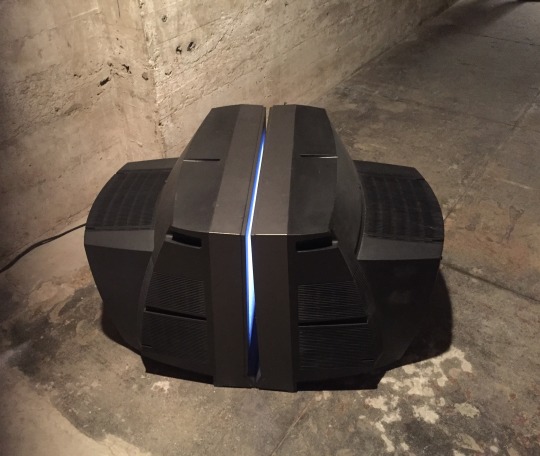
Douglas Gordon 24-hour psycho 1993
it “uses a special computer system to slow down the original’s 109 minutes so that it takes 24 hours for the piece to run from start to finish. the standard cinematic rate of 30 frames/second is extended to the roughly 30 seconds/frame” p91
Frank Gillette and Ira Schneider wipe cycle 1968
“wipe cycle” confused, intrigued and excited viewers who were surprised to find themselves on television screens where commercial programming or taped images off other people had appeared just prior to their own. the piece was able to introduce uncertainty into a medium that was known for its direct address and, in early surveillance uses, mirror-like properties.”p100
Vito Acconci Centers 1971
http://www.vdb.org/titles/centers
article related: Video: The Aesthetics of Narcissism
https://people.ucsc.edu/~ilusztig/176/downloads/reading/rosalindkraus.pdf
issues and connection
All of these artists have some intention to confuse the audience about the function/usage of a media. Among their works, the media was supposed to do a certain thing but it was not doing that. A tv might be supposed to be playing commercials and shows, but it is playing the audience’s image; the video might be supposed to record but it is viewed as mirror by Vito Acconci.
0 notes
Text
Week3
One hand clapping
The entire exhibition absolutely depicted this them well. I understand the topic as the absence of response under the globalization and digital age. Taking Wong Ping’s work Dear, can I give you hand? for example (which is my favorite piece, I love it so much that I bought the book about this show), the work shows how the elderly survive(or not) in the new generation. I love the sentence in his video, which is translated in English as “I hate being overtaken by the new era”. But I feel the meaning of the sentence is more like “I hate being hunted by the new era”. I love Wong Ping’s approach of discussing digital age – to focus on the people who are not from this age. I read the travel notes and concept drawings for “Dear, can I give you hand?” in the book, I was so inspired by his way of tell the story. He noted down his inspiration from some small happening around him and tell them in humorous and absurd way. Here is one:
‘Today I called an Uber to go to the Guggenheim. The driver must have been new, because she kept going the wrong way. In the end, she had to borrow my phone (from me, a tourist) and use my GPS. I was a little upset, and wanted to give her a negative rating. Then I saw her phone call history on the monitor in her dashboard. I saw that she was always calling My Life, and I worried that maybe something had gone wrong with her life. But after thinking about it, I grew jealous of her --- at least she knows her life’s number. If she has any problem, she knows who to call.
I tapped her on the shoulder and asked, “Could you tell me how to reach My Life? I’ve got a lot of questions for it.”
She said, “It’s my life, find your own life yourself!”
After I got out of the car, I gave her a negative rating.’
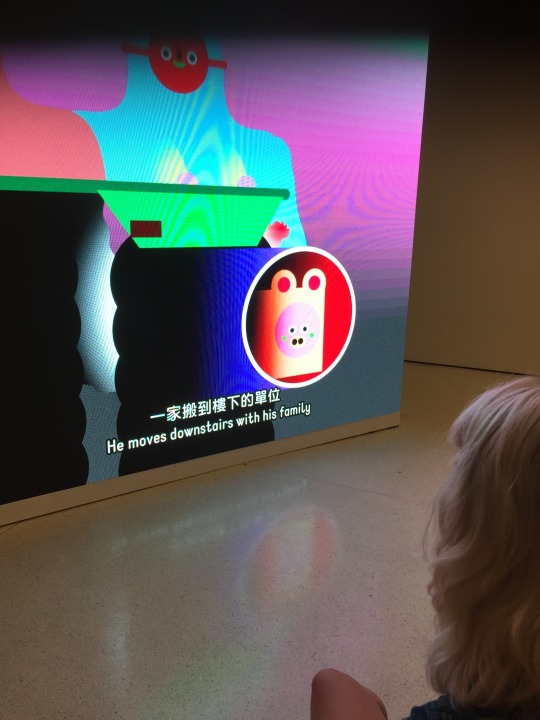
Also, this distance between the audience and the screen made me think. Why is the screen so close to the audience’s bench? It made the experience super uncomfortable – and the screen is huge and bright. I cant really see all the details of the animation. Interestingly, the distance gives me an overwhelming feeling to the bright screen, just like the elderly in the animation’s feeling to the new era, I suppose.
Cao Fei’s work depicted the unmanned factories and unmanned stores in the future. I think her video is always good at depicting the tension, even though the scenes sometimes are bizarre and hard to understand sometimes, but the tension is always obviously powerful, like her work Haze and Fog.
Giacomett
His earliest works are between 2d and 3d. It seems like he was experimenting with the combination of two-dimension and three dimension – I saw several works are flat faces with some drawing on. Later it seems like he was interested in cubism and surrealism. He explored composition and construction in his early works as well. And we can see those elements in his later work: especially in the sculpture that there are several figures existed.
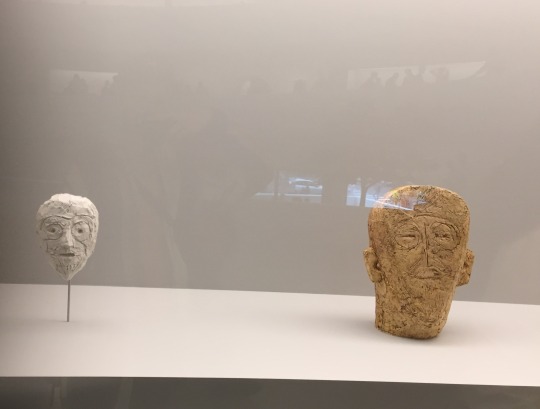
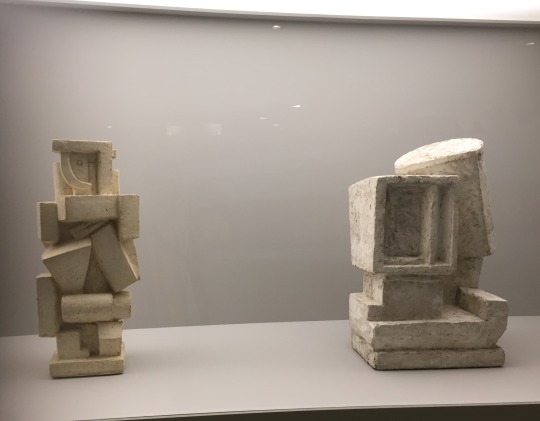
Later he formed a particular style – something between 2d and 3d, I think the texture on the sculpture is very similar to the brushstroke in his painting, the sculpture seems like a three-dimension version of his painting. Besides, some of his sculpture are two-dimension from some perspective, such as Tall Thin Head.
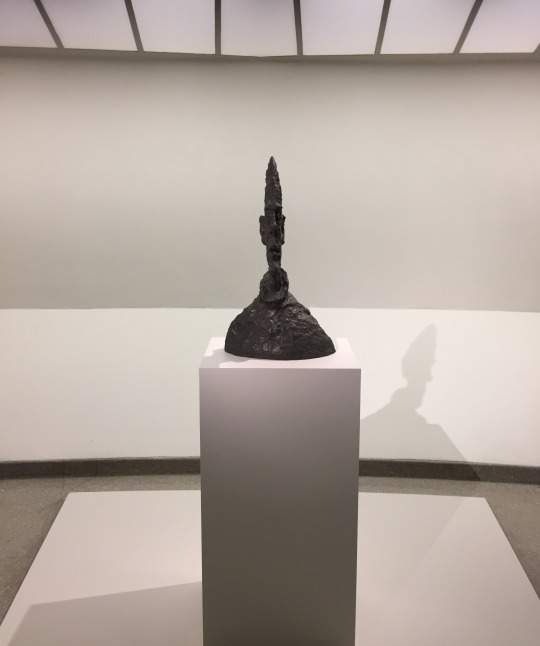
And he started to play with proportion, in some sculptures the heads are extremely small, some figures are extremely thin, there is one sculpture whose head is tiny, it makes you bow down to have a close look at the head. The experiment on scales show that tiny sculpture sometimes attract more intention and make the audience take a closer look and spend more time. A large one created a kind of distance from the audience. As he has a formed style, I feel the depression and loneliness in his work, and as the time goes it feels more depressed. The later painting emphasized on heads and the heads and face covered in black, both the color and the face look intense.
Mariko Mori
Bill Viola
Both of them created works on the theme of Buddhism. Mori’s work symbolized enlightenment and Viola’s work conveys the concept of macrocosm and microcosm. I prefer Viola’s work because I think he clearly depicted this theme in a combination of technology and natural element- water. However, Mori’s work I don’t really get the relationship between enlightenment and elements of air fire, water and earth. After all, I think enlightenment is a large concept both in Western and Eastern philosophy. I think she touches a huge theme, which might be a bit too broad. On the other hand, Viola’s approach to illustrate Buddhist idea is very effective and accurate as well. Besides, it is visually pleasant.
Tony Oursler
The Guardian described Oursler’s work in London as “a technological haunting in the park”. So the concept of Oursler’s world, I understand it as a spiritual world in the cyberspace. so is the artist analogizing the other world with the cyberspace? As I think about it, there are indeed some similarities between the spiritual world and the cyberspace. I don’t know why I connect “anonymity” to these two world. Also, projection on smoke is a very spooky and smart move, and it might change according to the weather condition. Does it work in a windy day? Might be an interesting experiment.
Bruce Nauman
I think the work is doing great in illustrating the isolation feeling, from that pre-recorded tape and the upper monitor’s distance. The participator get closer to the monitor, they appear in the monitor smaller. This is a very interesting inspiration for interactive art because the monitor always correspond to the viewer’s distance. The opposite way of display of monitor creates a sense of isolation very well. Although, I still don’t really get the surveillance part.
Robert Rauchenberg
I learned about Rauchenberg for his challenge to the concept of painting, he created some art which was three-dimensional, but hang on the wall, with a frame. In this work he seems to be challenging the concept that artwork is made by artist. This one was made by the audience and the artist, as every audience have a different perception of the art because of their own sound.
John Cage
John Cage opened a new discourse on the definitions of what art can be and what the process of making art can be. His works always involved the things that is not able to be controlled. Similar to Rauchenberg’s concept, the outcome of the work was unpredictable. John Cage’s 4′ 33″ piece was revolutionary. The concept of interactive art is similar as well. The involvement of the audience and other unpredictable element creates new thinking.
0 notes
Text
Week 2
This new museum doesn’t want Instagram or crowds. Does that make it elitist?
It is interesting that some museums attempts to control the visitor environment to achieve a better quality of exhibition experience, while some other museums are attempt to make them fully digital - like those virtual gallery - that people can access the artwork online and don’t even need to go to the actual space. Panther Modern is a virtual gallery curated by LaTurbo Avedon, it is actually a website but the curator uses it as a virtual installation space, and all the sculptures are digital files – might be the scene in Maya. The whole page is programed as if there is a real gallery and the installation are the photos taken in that gallery, but actually the whole gallery might be a model in Maya.
http://panthermodern.org/roomeleven.html
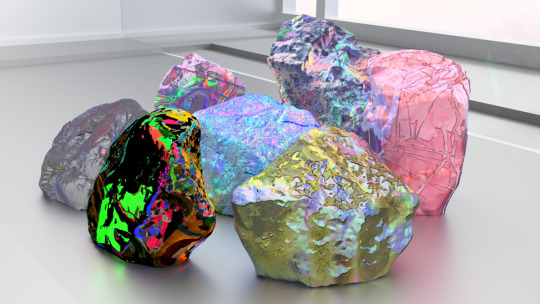
Olafur ELIASSON
I think the smart part of this installation is to let the audience to see the set up behind the beautiful view, I think it will be a nice contrast to see a spectacular natural view vs the electricity and technology that generate it. I think it is very ironic as well. The whole installation takes so much efforts to recreate the sun and the mist, but if you just walk out of the door you might see a misty London in a beautiful sunset view.
Jenny HOLZER
I don’t really get the meaning of this public installation, so I looked this artist up and found that she uses text in all of her works, sometimes well-known building, space and sometimes trucks. It reminds me of the posts that only have text on Instagram -- while other posts are all selfies and photos, the word post always catch attentions among those pictures. I don’t really understand the meaning of the texts, my understanding is that the artist might want to show the contrast between the tension of a serious ritual setup and the words which not match this set up?
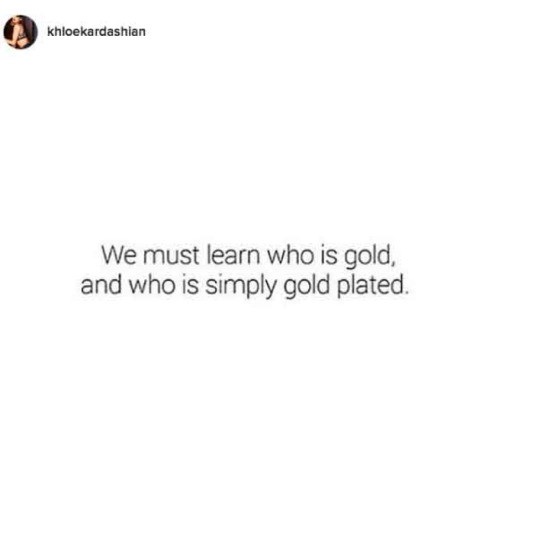
James TURREL
It seems like Turrel loves to trick the audience about the space. I like the description saying that the audience find that this cube is just a projection of light, like holograms or virtual reality, suggesting a substance that does not really exist. So it seems like an imitation of virtual subject using real subject – if we perceive this light as reality.
Also I want to quote the introduction on his webpage: “Turrell often cites the Parable of Plato’s Cave to introduce the notion that we are living in a reality of our own creation, subject to our human sensory limitations as well as contextual and cultural norms.” Which explain a lot that why he wants to trick audience’s sensory.
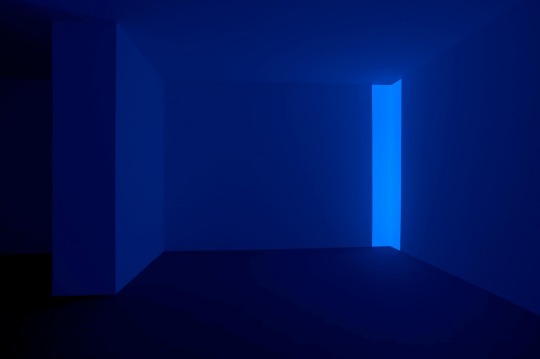
Tatsuo MIYAJIMA
The artist is making installation to experiment with the concept of time. In his interview on his webpage he said that he made art to raise questions to himself and to the public. I think the concept of eternity is also a question that he raise to the audience. But why 300 thousand years? I am curious about this number and I cannot figure out why.
Jean DUPUY
My interpretation is that the artist experimented the concept of time with organic life, compared to Miyajima’s philosophic and religious approach. Additionally the interval time gap between heartbeat is so recognizable that it successfully connects time to life. I realize how much similar from heartbeat to clock ticking -- they can last for a period of time, they keep changing(they both have the tick, and the rest, and the tick) and they also following a pattern repeatedly.
Eadweard Muybridge
I think this artist is also showing the concept of time, but using media as his approach. When time-based media was invented, there were a lot of art created on the theme of time. time-based media challenged the way that still images indicate the motion, but in fact, time-based media achieve the moving action by multiple frames, which is just a larger number of still images. It reminds me of a classmate’s work about time-based media: he record a 40 mins video and cut them into 4 piece and play them on 4 laptops synchronously. I love that piece because he was playing around with time and media, messing around with the concept of time and the term ‘time-based media’.
0 notes
Text
Week 1
MoMA PS1
Land: Zhang Huan and Li Binyuan
I think their works are extremely powerful.
The descriptions of works are comparably long and detailed. It might be because the context of the work has many cultural reference, or it might be because the artists want to be that way. Even though I think the artworks work powerfully without the text, but the artist might think it is necessary to make his intent and performance clear and understandable.
The first big screen is a performance in which the artist conducts a two-hour process of jumping into the air and falling back down into the muddy patch of soil until he was on the verge of collapsing from exhaustion. Li has explained the jump as departure and the fall as return. I interpret the exhaustion at the end is the person’s final death, just like his father’s passing (on the text). It strongly tells a story about the land-people relationship, the land raises him, he comes, he goes, and finally go back to the land – his body buried in the mud of the land. In this series of artworks, artists also show the relationship between human and nature, such as To Add One Meter to an Anonymous Mountain, To Raise the Water Level in a Fishpond. They all depict a picture of collectivism and the limits of human beings’ power over nature. In Drawing Board, Li pits his body against a powerful cascade of water that spills through an opening in a dilapidated roadside dam. He holds a wooden board against the surge of water. When my friend and I see this, we see his pose – he stood knee-deep in the water, holding the board against the strength of the water, we feel the balance between he and nature. Later his strength is running out, he falls down in the water and collapses. The balance is broken, all of a sudden we feel the fragility of the human body in front of the nature’s power.
The most powerful and impressive piece is Nine Holes. Zhang and his artist friends --- seven men and two women perform a kind of symbolic intercourse with the land. I normally don’t think the intercourse artwork is powerful, because there are too many. But the intercourse with the land is much more than the intercourse itself. The theme of human-nature relationship is always about balance and imbalance. But his performance describes human-nature relationship to a new level, I think rather than balance and imbalance, “exchange” is more accurate to describe the body and the land. Nine Holes is the exact continuity to the jump piece at the beginning.
Fernando Palma Rodriquez: In Ixtli in Yollotl, We the People
One aspect I like about this show, is the sculptures appear to me as fragmentation and deconstruction. They certainly convey the themes that the artist was trying to state – violence, land, land-people relationship and indigenous culture. Robotic hands, house heads, butterflies, seeds, dead birds and stones. Those fragmented story reminds me of newspaper. The news on local newspaper are fragment and altogether form a story of history, stating the emotion of the land and the land-people relationship. However, one aspect I don’t like about these sculptures is that they all seem like interactive sculptures, but at the end I don’t know whether they are or not. The audience are all wandering around to see if they are interactive. I saw Arduino were installed, but it seems not that effective. The audience there were confused as well. I think that is indeed a downside of interactive pieces, they sometimes make people focus on the technology, instead of on the artwork itself. However, if the artworks seem like interactive pieces, but actually just moving instantly by themselves, then that is a very interesting presentation and there is some context hidden by this move, but I am not able to tell if the interactive part is deliberate.
Seth Price: Danny, Mila, Hannah, Ariana, Bob, Brad
I think the most interesting point about Price’s work is the scale. There are a lot of works showing the scene of violence, the interaction, the movement and so on. But Price’s works choose to zoom in. He chooses to zoom extremely in, to the extreme that we might feel uncomfortable, to show the theme of violence. This zoom-in view isolate the identity of the models, which I read it as equality.
DDA Faculty show
Carla’s work Pattern Recognition has a reference of another artist’s face, who I can’t recognize. It reminds me of the “reference pleasure” that one of my professor in my undergrads mentioned. The audience who recognize the reference in the artwork got much more pleasure than the audience who do not recognize it. Some artworks are designed to be appreciated by the one who can recognize the reference in the work. I would say maybe all arts are not designed to be seen by all people. Most of arts have reference, sometimes national social issues, philosophy problem, and sometimes more specific like persons, books, other artworks.

The work The Year We Make Contact I still not sure if it is interactive, but the tape and the shape of projection remind me of the shape of early computer screen. Maybe the artist is referring to the first computer screen? The show does not have long description like the one in MoMA PS1, the only clue we can fine is the text on the artist tag. It makes me wonder a question, for an artwork, sometimes what the audience receive and what the artist trying to say are different, but which one is more important?
Readings:
"Redefining Sculpture Digitally"
quote:
“At what point, as we add and refine perceptual cues, do we cease to think of the object as being “virtual” and just think of it as real? If we can see a single view of what appears to be a three dimensional object, is it a “real” object? No, we say, because we can't walk around it. If we can “walk around it” by using a joystick to control our point of view, is it then real? Suppose the image is displayed to us not on a stationary monitor set on a table, but in a tiny head-mounted monitor that reads our body movements and updates the image accordingly, so that we can physically walk around it. Is it then “real”? And if there are two images – a left eye view and a right eye view – so that we see the object in stereo, as our eyes normally do? Suppose we program into the object virtual tangibility, so that we can “feel” the object – perhaps with a set of electronic gloves that would be to our sense of tactility as CRT monitors now are to our sense of vision. And if we add sound? And scent?
How many, and which, characteristics must the object have before we consider it real? Or before we become incapable of distinguishing between what is real and what is not? Or before we cease to care about the distinction? (6)”
The reading makes me keep thinking the definition of virtual and reality, or even sculpture, which is defined in “introduction to Art Concepts, SAC, ART100″ (https://courses.lumenlearning.com/sac-artappreciation/chapter/oer-1-25/) as “ any artwork made by the manipulation of materials resulting in a three-dimensional object”. By looking at this definition, I still cannot decide that whether my object in Maya can be called as sculpture. I always call the work in Maya as “virtual installations” even though it will finally be presented as two-dimensionally. Because I think I was making installation, to express an idea, but digitally instead of physically. For “the work in Maya”, I was manipulating data to make an artwork, and the object was three-dimensional. So if data can be defined as “materials”, then the thing in Maya can be sculpture.
I believe Virtual Reality is a challenge to the definition of “virtual” as well as “really”. We can somehow “physically” walk around it. With the headset on, we basically cannot receive the sound from the physical world. When our sense immerse in the VR world, is this still “virtual”? When playing with VR, I feel terrifying. Because my sense is in an environment but my body is not. I still can feel my body in the physical world, without my sense, my body feel even more unprotected. It still challenges “virtuality” by taking away some senses. but it is awkward that it takes only some senses but not all of them.
"A Series of Digital Interactive Multimedia Murals"
quote:
“This is also why abstract painting and sculpture can succeed. Willem de Kooning’s painting, A Tree in Naples, is powerful not because it represents a moving event of thing. In fact, we cannot say that it “represents” anything (in spite of the title). The painting is powerful because of the relationships between the forms and colors. These relationships are somehow analogous to experiences we have had, and that is why we respond viscerally to the painting.”
In addition to the “analogous” effects that art serve, I think powerful art also have the ability to make the audience strongly feel something. I strongly agree that good art have this analogous effects, and also I think that the same principle can be applied to more dimensional art such as sculptures and performances. In a discourse on the beautifulness of art, I commented that the beautifulness of art impresses the audience not because of how much pleasure it brings, but how much feeling that it can generate, which means, the power of art does not depend on how beautiful the art is, but how much feelings that it can generate. For instance, Chris Burden’s performance: Shoot (1971) and Through the Night Softly (1973). They are powerful not because the pleasure they bring --- they did not bring any pleasure, they are ugly, if I would say --- but because how much pain that they can let the audience feel, which is “analogues” effects described in the reading. In Through the Night Softly (1973) Burden was slithering across broke glass in his underwear with his hands bound behind his back and in Shoot (1971), Burden was shot in front of the audience. (I can not imagine how shocked the audience were when witnessing the artist being shot during this performance.)
0 notes